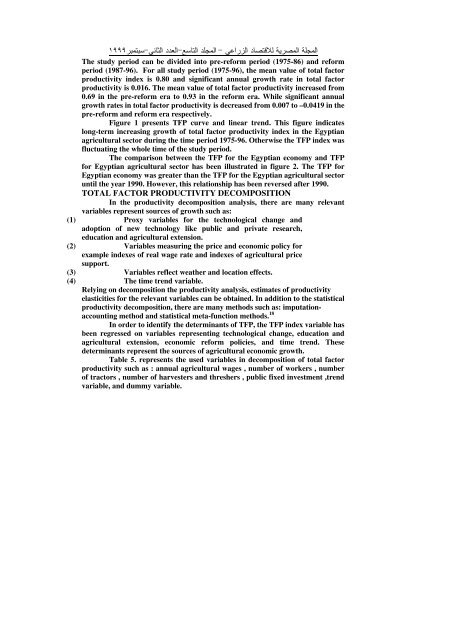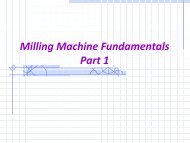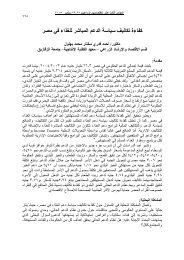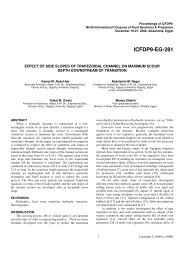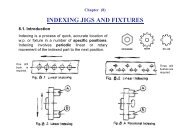Total Factor Productivity and Sources of Long-Term Growth in ...
Total Factor Productivity and Sources of Long-Term Growth in ...
Total Factor Productivity and Sources of Long-Term Growth in ...
You also want an ePaper? Increase the reach of your titles
YUMPU automatically turns print PDFs into web optimized ePapers that Google loves.
- - - <br />
The study period can be divided <strong>in</strong>to pre-reform period (1975-86) <strong>and</strong> reform<br />
period (1987-96). For all study period (1975-96), the mean value <strong>of</strong> total factor<br />
productivity <strong>in</strong>dex is 0.80 <strong>and</strong> significant annual growth rate <strong>in</strong> total factor<br />
productivity is 0.016. The mean value <strong>of</strong> total factor productivity <strong>in</strong>creased from<br />
0.69 <strong>in</strong> the pre-reform era to 0.93 <strong>in</strong> the reform era. While significant annual<br />
growth rates <strong>in</strong> total factor productivity is decreased from 0.007 to –0.0419 <strong>in</strong> the<br />
pre-reform <strong>and</strong> reform era respectively.<br />
Figure 1 presents TFP curve <strong>and</strong> l<strong>in</strong>ear trend. This figure <strong>in</strong>dicates<br />
long-term <strong>in</strong>creas<strong>in</strong>g growth <strong>of</strong> total factor productivity <strong>in</strong>dex <strong>in</strong> the Egyptian<br />
agricultural sector dur<strong>in</strong>g the time period 1975-96. Otherwise the TFP <strong>in</strong>dex was<br />
fluctuat<strong>in</strong>g the whole time <strong>of</strong> the study period.<br />
The comparison between the TFP for the Egyptian economy <strong>and</strong> TFP<br />
for Egyptian agricultural sector has been illustrated <strong>in</strong> figure 2. The TFP for<br />
Egyptian economy was greater than the TFP for the Egyptian agricultural sector<br />
until the year 1990. However, this relationship has been reversed after 1990.<br />
TOTAL FACTOR PRODUCTIVITY DECOMPOSITION<br />
In the productivity decomposition analysis, there are many relevant<br />
variables represent sources <strong>of</strong> growth such as:<br />
(1) Proxy variables for the technological change <strong>and</strong><br />
adoption <strong>of</strong> new technology like public <strong>and</strong> private research,<br />
education <strong>and</strong> agricultural extension.<br />
(2) Variables measur<strong>in</strong>g the price <strong>and</strong> economic policy for<br />
example <strong>in</strong>dexes <strong>of</strong> real wage rate <strong>and</strong> <strong>in</strong>dexes <strong>of</strong> agricultural price<br />
support.<br />
(3) Variables reflect weather <strong>and</strong> location effects.<br />
(4) The time trend variable.<br />
Rely<strong>in</strong>g on decomposition the productivity analysis, estimates <strong>of</strong> productivity<br />
elasticities for the relevant variables can be obta<strong>in</strong>ed. In addition to the statistical<br />
productivity decomposition, there are many methods such as: imputationaccount<strong>in</strong>g<br />
method <strong>and</strong> statistical meta-function methods. 18<br />
In order to identify the determ<strong>in</strong>ants <strong>of</strong> TFP, the TFP <strong>in</strong>dex variable has<br />
been regressed on variables represent<strong>in</strong>g technological change, education <strong>and</strong><br />
agricultural extension, economic reform policies, <strong>and</strong> time trend. These<br />
determ<strong>in</strong>ants represent the sources <strong>of</strong> agricultural economic growth.<br />
Table 5. represents the used variables <strong>in</strong> decomposition <strong>of</strong> total factor<br />
productivity such as : annual agricultural wages , number <strong>of</strong> workers , number<br />
<strong>of</strong> tractors , number <strong>of</strong> harvesters <strong>and</strong> threshers , public fixed <strong>in</strong>vestment ,trend<br />
variable, <strong>and</strong> dummy variable.


